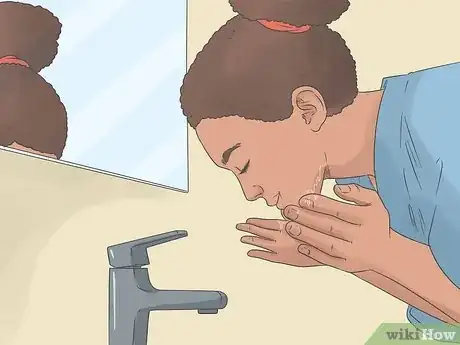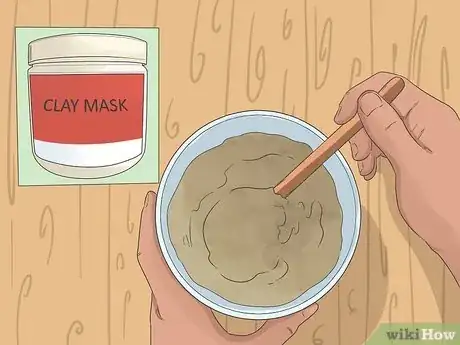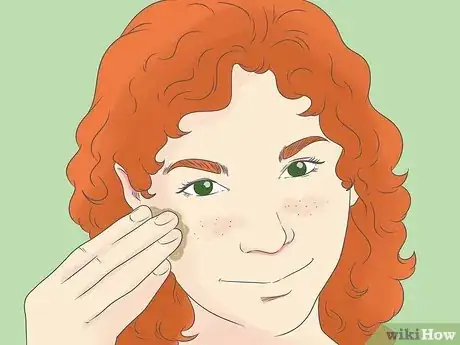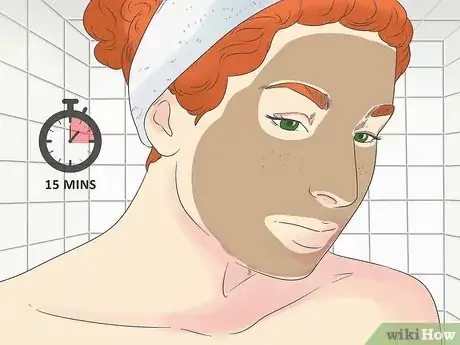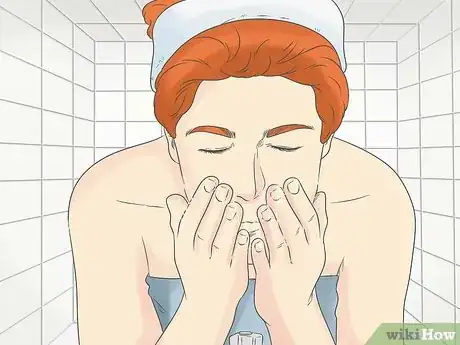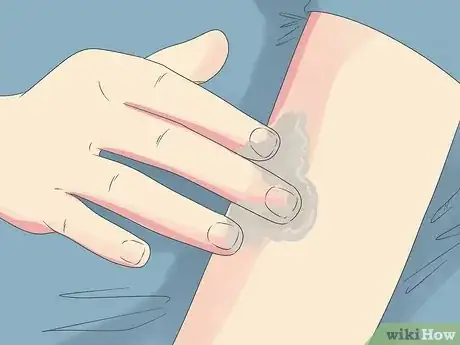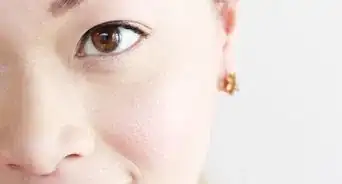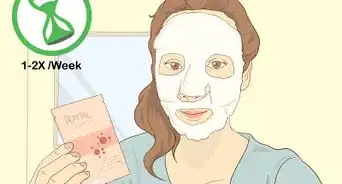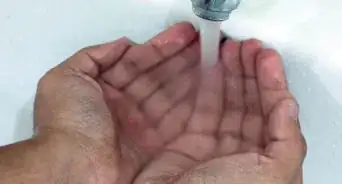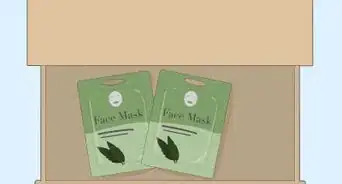This article was co-authored by Lydia Shedlofsky, DO. Dr. Lydia Shedlofsky is a Resident Dermatologist who joined Affiliated Dermatology in July of 2019 after completing a traditional rotating internship at Larkin Community Hospital in Miami, Florida. She earned a Bachelor of Science in Biology at Guilford College in Greensboro, North Carolina. After graduation, she moved to Beira, Mozambique, and worked as a research assistant and intern at a free clinic. She completed a Post-Baccalaureate program and subsequently earned a Master's Degree in Medical Education and a Doctorate of Osteopathic Medicine (DO) from the Lake Erie College of Osteopathic Medicine.
wikiHow marks an article as reader-approved once it receives enough positive feedback. In this case, several readers have written to tell us that this article was helpful to them, earning it our reader-approved status.
This article has been viewed 64,882 times.
Dead Sea mud, filled with minerals like magnesium, calcium, and iron, is well-known for its therapeutic and beauty effects. You can spread the black mud, which is available online and at some spas, on your face and body to improve the health and look of your skin and even lessen joint pain. The mud's healing properties derive from the unique salinity and minerals in the Dead Sea, which is located between Jordan, Israel, and the West Bank.
Steps
Preparing the Face for Dead Sea Mud
-
1Wash your face. Before you apply the Dead Sea mud to your face, clean your face thoroughly with water and open your pores with a warm cloth.[1]
- Remove any makeup or grease that’s on your face. Use your regular cleanser or makeup remover. Then, put a washcloth in hot water and wring it out.
- Place the washcloth on your face, and gently use it to wipe your skin. You want it to feel warm but not too hot.
- Leave the cloth on your face until it cools down, which should take about half a minute. The warmth of the cloth should open your pores.
-
2Mix the mud mask together. The Dead Sea mud mask is often mixed together with other oils for increased softness of the skin. The mud may arrive with some salty sea water on the top. Stir it back together if you see that.
- Take a small bowl, and apply 1 teaspoon of Dead Sea mud to it. Remember that you don’t need very much of it for each mask.
- Apply various oils to the mud. The most commonly used oils are myrrh essential oil, frankincense essential oil, and rose otto essential oil. The mud minimizes pores and is said to reduce wrinkles!
- Use 2-4 drops of the myrrh oil and 2 drops of the frankincense oil. The rose otto oil is optional. Mix the concoction together with a spoon.
Advertisement -
3Moisturize your eyes. It’s important to moisturize your eyes before applying the Dead Sea mask. That’s because the skin around your eyes is thinner and more delicate.
- Take a couple drops of a natural oil like coconut or olive oil, and apply it gently to the skin around your eyes. Be careful not to get it in your eyes.
- You will naturally apply the oil more gently if you use your ring fingers when touching the area around your eyes.
- Take care not to press too hard on the eye area as it’s sensitive. The oil will also protect your eyes when the mask is applied. Also, avoid getting the mud around or in your eyes but also avoid areas of the face that you regularly wax.
Applying the Dead Sea Mud to Your Face
-
1Apply a mud mask. Dead Sea mud can be purchased in a jar. It’s not a dry, powder-like beauty clay. Rather, it’s a moist and fairly thick clay-like mud. It also comes in powder form; add water and mix in that case.
- The mud doesn’t spoil because of the germicide that’s added to it.[2] Start by applying the mud to your face using your fingers. Remember to apply it in a thin layer.[3]
- Use small circular movements to apply the mud mask to your face. Be very careful to avoid getting it in the area of your eyes. Try not to get the mud in your hair. Use upward motions to apply the mud.
- Skipping the eye area, apply the mud thinly and uniformly throughout your entire face, including underneath your chin. If you have a breakout on any area of your skin, also skip that part.
-
2Let the mud dry naturally on your face. This should take about 12-15 minutes. If the mud takes a lot longer to dry, then you’ve probably slathered it on too thick. It’s best to sit up while it dries, but if you do lie down, rest your head on a towel.
- The mud should remove impurities from your skin, detoxify it, and cleanse it. Your skin should feel softer and more elastic after the mud has been applied and then removed. It should look brighter.
- Remove the mask right away if your skin starts to itch at any point. Some people have had allergic reactions to Dead Sea mud. The mud will tighten pores, remove excess skin oil, and the salt in it should get rid of any surface bacteria which lowers the number of breakouts you could get.
- It’s natural for your skin to feel a little tingly as the mask starts to dry. Don’t worry about it unless you feel a stronger burning sensation.
-
3Rinse off the mud. Once the mud has dried, it’s time to remove it from your skin. This shouldn’t be very difficult to do.
- Use warm water to rinse the mud from your skin like you would any other mask. It may take some time rinsing the face to remove all the mud.
- Try using a clean washcloth to help you wipe the mud off your face. Dry your face by patting it down with a towel or other clean cloth.
- Apply a moisturizer to your face. Coconut oil is a great natural moisturizer, but any moisturizer you regularly use would do. Use the Dead Sea mask weekly.
- You can buy Dead Sea mud through some specialty beauty stores and through many online sites. The Egyptians used balms made from the water of the Dead Sea for their mummification process; today you can also find Dead Sea products in the most exclusive spas around the world. However, it's no more expensive than most designer skin lotions if you purchase it online.
Using the Mud for Other Health and Beauty Purposes
-
1Make a body mask. Dead Sea mud isn’t only used to make your face softer; you can also use it to reduce joint and muscle pain. Dead Sea mud has 26 minerals in it!
- Mix ¼ cup of the mud with 5 drops of lavender essential oil, 2 drops of rosemary essential oil, and 1 drop of peppermint essential oil. In this case, heat the mud by putting the mud over a pan of steaming water. You want it to be a little bit higher than body temperature.
- Smear the warmed up mud on any muscles or joints that are hurting. Massage the mud into the areas, let the mask dry, and then wash it off with warm water just as you would your face.
- Apply the mud to your knees, elbows or other joints that are afflicted with osteoarthritis. This mineral-rich mud pack has been proven by researchers at the Ben Gurion University of the Negev in Israel to reduce inflammation in the joints.
-
2Put Dead Sea mud in your hair. The mineral-rich mud has many purposes. One of them is to increase the health of your hair.
- The mud will also reduce the chances that you will have dandruff, and it’s going to increase the shine in your hair.
- Start by massaging the mud into your scalp. Work it throughout all of your hair.
- Let the mask remain in your hair for about 20 minutes so that your hair gains the fuller benefit of the many minerals in the mask.
- Rinse your hair thoroughly with water as you would rinse out shampoo. It may take a few attempts before you fully remove the mud from your hair.
-
3Treat eczema and psoriasis. The Dead Sea mud will do more than increase your skin's softness; it also can be used to help people with more serious skin issues.
- People who suffer with dermatological conditions such as eczema and psoriasis find that the application of Dead Sea mud to afflicted areas not only reduces swelling, but it takes the heat out of inflammations.
- The Dead Sea mud also vastly reduces the itching, making it an effective holistic treatment for these ailments.[4]
- Apply the Dead Sea mud like you would apply it for facial beauty purposes. Some people also believe the minerals in the mud can help cancer patients and those undergoing chemotherapy, but this is not proven. Check with your doctor first.
Expert Q&A
-
QuestionAre mud masks effective?
 Alicia RamosAlicia Ramos is a licensed aesthetician and the owner of Smoothe Denver in Denver, Colorado. She received her license at the School of Botanical & Medical Aesthetics, with training in lashes, dermaplaning, waxing, microdermabrasion, and chemical peels, and now provides skin care solutions to hundreds of clients.
Alicia RamosAlicia Ramos is a licensed aesthetician and the owner of Smoothe Denver in Denver, Colorado. She received her license at the School of Botanical & Medical Aesthetics, with training in lashes, dermaplaning, waxing, microdermabrasion, and chemical peels, and now provides skin care solutions to hundreds of clients.
Skincare Professional Definitely! A mud mask has live cultures, which makes it really great to use at home.
Definitely! A mud mask has live cultures, which makes it really great to use at home. -
QuestionWho should use clay masks?
 Alicia RamosAlicia Ramos is a licensed aesthetician and the owner of Smoothe Denver in Denver, Colorado. She received her license at the School of Botanical & Medical Aesthetics, with training in lashes, dermaplaning, waxing, microdermabrasion, and chemical peels, and now provides skin care solutions to hundreds of clients.
Alicia RamosAlicia Ramos is a licensed aesthetician and the owner of Smoothe Denver in Denver, Colorado. She received her license at the School of Botanical & Medical Aesthetics, with training in lashes, dermaplaning, waxing, microdermabrasion, and chemical peels, and now provides skin care solutions to hundreds of clients.
Skincare Professional Mud masks are great for people with oily skin, but they aren't a great fit for people with more mature, dry skin.
Mud masks are great for people with oily skin, but they aren't a great fit for people with more mature, dry skin. -
QuestionHow do you make a simple mud mask?
 Lydia Shedlofsky, DODr. Lydia Shedlofsky is a Resident Dermatologist who joined Affiliated Dermatology in July of 2019 after completing a traditional rotating internship at Larkin Community Hospital in Miami, Florida. She earned a Bachelor of Science in Biology at Guilford College in Greensboro, North Carolina. After graduation, she moved to Beira, Mozambique, and worked as a research assistant and intern at a free clinic. She completed a Post-Baccalaureate program and subsequently earned a Master's Degree in Medical Education and a Doctorate of Osteopathic Medicine (DO) from the Lake Erie College of Osteopathic Medicine.
Lydia Shedlofsky, DODr. Lydia Shedlofsky is a Resident Dermatologist who joined Affiliated Dermatology in July of 2019 after completing a traditional rotating internship at Larkin Community Hospital in Miami, Florida. She earned a Bachelor of Science in Biology at Guilford College in Greensboro, North Carolina. After graduation, she moved to Beira, Mozambique, and worked as a research assistant and intern at a free clinic. She completed a Post-Baccalaureate program and subsequently earned a Master's Degree in Medical Education and a Doctorate of Osteopathic Medicine (DO) from the Lake Erie College of Osteopathic Medicine.
Dermatologist I recommend buying a branded product over attempting to make your own due to risks of contaminants in the soil. There is currently a lack of data for the overall benefits of mud masks. If you're using a mask with a goal in mind, I strongly recommend that you go to your local dermatologist for recommendations.
I recommend buying a branded product over attempting to make your own due to risks of contaminants in the soil. There is currently a lack of data for the overall benefits of mud masks. If you're using a mask with a goal in mind, I strongly recommend that you go to your local dermatologist for recommendations.
Warnings
- Dead Sea mud should be used immediately after mixing it with water. Do not attempt to store it in any form other than how you purchased it.⧼thumbs_response⧽
- Seek medical attention immediately if you do ingest it or if it does get into your eyes.⧼thumbs_response⧽
- Dead Sea mud should only be used topically. Do not ever ingest it, or allow it to come in contact with the eyes, nostrils, mouth or other sensitive areas.⧼thumbs_response⧽
